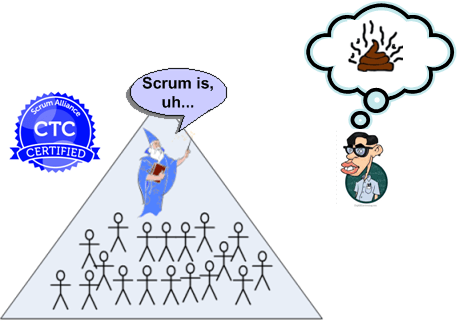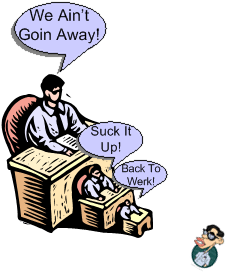Archive
First Confuse Them, And Then Unconfu$e Them
I don’t understand it. I simply don’t understand how some (many?) Scrum coaches and consultants can advocate dumping the words “estimates” and “backlogs” from Scrum.
The word “estimate” appears 9 times in the 16 page Scrum Guide:
- All incomplete Product Backlog Items are re-estimated and put back on the Product Backlog.
- The work done on them depreciates quickly and must be frequently re-estimated.
- Work may be of varying size, or estimated effort.
- Product Backlog items have the attributes of a description, order, estimate and value.
- Product Backlog refinement is the act of adding detail, estimates, and order to items in the Product Backlog
- More precise estimates are made based on the greater clarity and increased detail; the lower the order, the less detail.
- The Development Team is responsible for all estimates.
- ..the people who will perform the work make the final estimate.
- As work is performed or completed, the estimated remaining work is updated
As for the word “backlog“, it appears an astonishing 80 times in the 16 page Scrum Guide.
People who make their living teaching Scrum while insinuating that “estimates/backlogs” aren’t woven into the fabric of Scrum are full of sheet. How in the world could one, as a certified Scrum expert, teach Scrum to software development professionals and not mention “estimates/backlogs”?
Even though I think their ideas (so far) lack actionable substance, I have no problem with revolutionaries who want to jettison the words “estimates/backlogs” from the software development universe. I only have a problem with those who attempt to do so by disingenuously associating their alternatives with Scrum to get attention they wouldn’t otherwise get. Ideas should stand on their own merit.
If you follow these faux-scrummers on Twitter, they’ll either implicitly or explicitly trash estimates/backlogs and then have the audacity to deny it when some asshole (like me) calls them out on it. One of them actually cranked it up a notch by tweeting, without blinking an e-eye, that Scrum was defined before Scrum was defined – even though the second paragraph in the Scrum guide is titled “Definition Of Scrum“. Un-freakin-believable.
Sorry, but I lied in the first sentence of this post. I DO understand why some so-called Scrum advocates would call for the removal of concepts integrally baked into the definition of the Scrum framework. It’s because clever, ambiguous behavior is what defines the consulting industry in general. It’s the primary strategy the industry uses very, very effectively to make you part with your money: first they confuse you, then they’ll un-confuse you if you “hire us for $2K /expert/day“.
…and people wonder why I disdain the consulting industry.
The best book I ever read on the deviousness of the consulting industry was written by a reformed consultant: Matthew Stewart. Perhaps you should read it too:
In Defense Of Hierarchy
The word “hierarchy” gets no respect. Except for popes, generals, executives, and managers, who tend to thrive exquisitely in command and control hierarchies, many people associate hierarchical social structures with ineffectual bureaucracy, back-stabbing politics, patronization, unfair distribution of status and rewards, and suppression of individual initiative.
Despite all the bad press, hierarchically structured social systems do have benefits; even for those residing in the lowest tiers of the pyramid. One benefit that hierarchy serves up is… orderly execution of operations:
Imagine if students argued with their teachers, workers challenged their bosses, and drivers ignored traffic cops anytime they asked them to do something they didn’t like. The world would descend into chaos in about five minutes. – Duncan J. Watts
In “Influence” Robert Cialdini writes:
A multi-layered and widely accepted system of authority confers an immense advantage upon a society. It allows the development of sophisticated structures for resource production, trade, defense, expansion, and social control that would otherwise be impossible. The other alternative, anarchy, is a state that is hardly known for its beneficial effects on cultural groups and one that the social philosopher Thomas Hobbes assures us would render life “solitary, poor, nasty, brutish, and short.”
I don’t agree with Mr. Cialdini that the alternative to hierarchy is pure anarchy, but his point, like Mr. Watts’s, is a good one.
Management “guru” Tom Peters (to whom I used to closely listen to prior to reading Matt Stewart’s brilliant “The Management Myth“), sums it up nicely with:
Hierarchy will never go away. Never!
The Creation Of A New Class
In the context of complex decisions with uncertain outcomes and no obvious right answer, the managerial mind inevitably longs for some handrails to grasp amid the smoke and flames. Strategic planning offers that consolation— or illusion— of a sure path to the future – Stewart, Matthew
In “The Management Myth“, Matthew Stewart researches how the business of “Business Strategy” got started and how it evolved over the decades. He (dis)credits Igor Ansoff with starting the phantom fad founded on “nonfalsifiable tautologies, generic reminders, and pompous maxims“. Mr. Stewart also credits mainstream strategy guru Michael Porter with growing the beast in the nineties into the mega-business it is today.
Perhaps the most interesting outcome from the rise of the business of strategy was the stratification of “management” into two classes, top management and middle management:
Top management takes responsibility for deciding on the mix of businesses a corporation ought to pursue and for judging the performance of business unit managers. Middle management is said to be responsible for the execution of activities within specific lines of business. This division within management has created a new and problematic social reality. In earlier times, there was one management and there was one labor, and telling the two apart was a fairly simple matter of looking at the clothes they wore. The rise of middle management has resulted in the emergence of a large group of individuals who technically count as managers and sartorially look the part but nonetheless live very far down the elevator shaft from the people who actually have power – Stewart, Matthew
I always wondered how the delineation between “top” and “middle” management came about. Now I know why.
Bundles Of Emotions
Without a doubt, the most impactful (and depressing) management book I’ve read over the past few decades is Matthew Stewart’s “The Management Myth“. In his unforgettable masterpiece, Mr. Stewart interweaves his personal rise-and-fall story as a highly paid management consultant with the story of the development of management “science” during the 20th century. Both tracts are highly engaging, thought-provoking, and as I said, depressing reads.
At the end of this post, I’m gonna present a passage from Matt’s book that compares the Winslow and Mayo approaches to “scientific” management. But before I do, I feel the need to provide some context on the slots occupied by Winslow and Mayo in the annals of management “science“.
The Taylor Way
Frederick Winslow Taylor is considered by most to be the father of “scientific” management. In his management model, there are two classes of people, the thinkers (managers) and the doers (workers). Thinkers are elites and workers are dumbasses. By increasing piece/hour pay, Taylor’s model can be used to mechanistically increase efficiency, although it doesn’t come for free. Executed “scientifically“, the increase in labor cost is dwarfed by the increase in profits.
The Mayo Way
Elton Mayo, although not nearly as famous as Doug MacGregor (the eloquent theory X and X guy who I liked very much before reading this obscene book), is considered to be one of the top “scientists“, and perhaps creator of, the human relations branch of management (pseudo)science. In Mayo’s management model, there are also two classes of people, the thinkers (managers) and the feelers (workers). Thinkers are also elites, but workers are bundles of emotions. By manipulating emotions, Mayo’s model can be used to “humanely” increase efficiency. But unlike the reviled, inhumane, Taylor model, the efficiency gains from Mayo’s “nice” model are totally free. A double win! Productivity gains in an ethical manner with no additionally incurred financial cost to the dudes in the head shed. Management is happy and the workery is a happy, self-realized community. W00t!
The Quote
OK, now with the context in place, here’s the passage I promised:
Mayo’s drive for control makes Taylor look like a placard-waving champion of the workingman. The father of scientific management may have referred to his workers as “drays” and “oxen,” but with his incentive-based piece-rate systems he nonetheless took for granted that these beasts of burden had the capacity to make economic decisions for themselves on the basis of their material self-interest. In Mayo’s world, however, the workers of the world lack this basic rational capacity to act in their own self-interest. – Stewart, Matthew (2009-08-10). The Management Myth: Why the Experts Keep Getting it Wrong (p. 135). W. W. Norton & Company. Kindle Edition.
When I first read that passage, it sent an uncomfortable shiver down my spine. Was it as good for you as it was for me?
Shoving all the preceding BD00 drama aside, I’d rather be happy (and duped?) making $XXXX than be miserable making the same amount. I just wish that badass Matt didn’t throw his turd in my damn punchbowl! 🙂
 In case you’ve been wondering why I’ve been relentlessly railing lately against the guild of agile coaches on Twitter, this post exposes my main motivational force. From what I’ve seen, the coaching community rarely, if ever, thinks or speaks or writes about where the fruits of their so-called 400% efficiency improvements end up. They either auto-assume that the tropical delights are doled out fairly, or the topic is taboo; undiscussable (RIP Chris Argyris).
In case you’ve been wondering why I’ve been relentlessly railing lately against the guild of agile coaches on Twitter, this post exposes my main motivational force. From what I’ve seen, the coaching community rarely, if ever, thinks or speaks or writes about where the fruits of their so-called 400% efficiency improvements end up. They either auto-assume that the tropical delights are doled out fairly, or the topic is taboo; undiscussable (RIP Chris Argyris).





